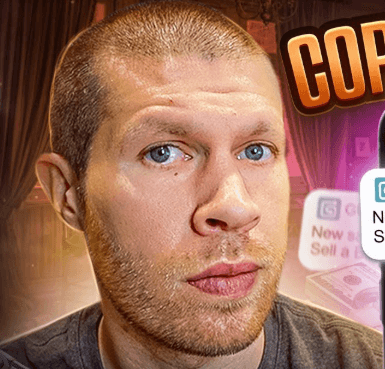How Brian Nagele Turns Viral Memes Into $20K/Month

Business Description
Table of Contents
Navigate through the case study sections
Executive Summary
Case Study Content
Turning Memes into a $20K/Month Venture
When he first started, Brian Nagele treated Facebook almost like a sketchbook. He posted offbeat, shareable memes about films, gadgets and day-to-day quirks just to see how people reacted. Within a few months, his audience began to grow. Shares went up, comments rolled in, and a simple hobby turned into a full-blown side income of $500 per month then $1,000, and eventually $20,000 every thirty days.
Why Memes Catch Fire
A meme works because it compresses an idea or joke into one glance. No long reads, no deep dives. People process an image and a line of text in an instant and decide if it belongs in their own feed. Brian studied trending tags on Twitter, Reddit and Instagram to see what patterns emerged. He learned that timing matters: a meme about a new streaming release hits harder than an old reference.
Building a Network of Niche Pages
Instead of relying on a single page, Brian launched several Facebook profiles for specific interests: classic movies, emerging tech humor, pet owner life and sports jokes. Each page spoke directly to fans who already lived and breathed those topics. He made sure each page looked and felt unique, with tailored profile images, cover photos and early content that set the tone.
Keeping Content on Schedule
One big trick was consistency. Brian set up a calendar that mapped out 3-5 daily posts per page. At first he used manual scheduling, but as the network grew he switched to tools that batch-uploaded images and captions at precise times. This way, each page stayed active even if he took a day off to rest or brainstorm new ideas.
Turning Likes into Dollars
Monetization came in two forms. First, he plugged Facebook Ads in between posts, choosing offers that appealed directly to page fans. Tech gadgets on the tech page, streaming service trials on the movie page. Second, he tested affiliate partnerships by embedding trackable links below certain memes. When a follower clicked and made a purchase, Brian earned a commission. Over time, those small payouts added up.
Dealing with Algorithm Shakes
Facebook’s algorithm changes hit hard. One week a page that was booming suddenly saw its reach cut in half. Instead of panicking, Brian ran A/B tests on post times, small variations in caption length and tag use. He tracked engagement rates, tweaked his approach and regained momentum. His willingness to test new variables kept his pages visible.
Expanding to Video and Other Platforms
He didn’t stop at static images. Short, punchy videos that riffed on trending topics started to appear on Instagram Reels and TikTok. He reused his best meme copy for video captions and added dynamic transitions. This drew new viewers who preferred video over pictures. Cross-posting those clips on multiple platforms widened his net, creating fresh streams of followers.
Collaborations and Sponsored Posts
As pages grew, brands approached Brian for sponsored content. He declined offers that felt forced but said yes to those that matched his audience. Movie studios, gadget marketplaces and sports merch vendors saw value in reaching a ready-made crowd. Brian negotiated flat fees or revenue shares, boosting his income beyond ads and affiliates.
Scaling Without a Team
Brian kept his team at just himself and a virtual assistant who handled scheduling. He used simple spreadsheets to track page performance, noting best times and themes. When his network reached ten pages, he added another assistant to handle graphic tweaks. That low overhead meant nearly all revenue stayed profit, allowing him to reinvest in ad credits and new pages rapidly.
Staying Ahead of Trends
What sets Brian apart is his habit of watching pattern shifts. He checks social feeds every morning and end of day to spot emerging jokes, hashtags and popular clips. He then turns those sparks into quick memes or short videos, sometimes posting within hours of a trend starting. That speed keeps his pages fresh and relevant.
Key Takeaways
- 1Brian harnessed the viral power of memes by tailoring content to specific niche audiences, ensuring high rates of shares and comments.
- 2Launching multiple Facebook pages allowed Brian to isolate and test themes, dramatically increasing his reach and engagement across different interest groups.
- 3Consistent posting schedules and use of scheduling tools kept pages active even when he took breaks, maintaining steady growth.
- 4Strategic use of Facebook Ads and relevant affiliate links under each meme turned casual shares into a combined $20,000 monthly income.
- 5Regular A/B testing of post times, formats and captions helped Brian quickly adapt to algorithm shifts and maintain high visibility.
- 6Expanding into short videos on platforms like TikTok and Instagram Reels introduced fresh audiences and diversified revenue channels.
Tools & Technologies Used
Premium Content Locked
Subscribe to access the tools and technologies used in this case study.
Unlock NowHow to Replicate This Success
Premium Content Locked
Subscribe to access the step-by-step replication guide for this case study.
Unlock NowInterested in Being Featured?
Share your success story with our community of entrepreneurs.
Explore More Case Studies
Discover other inspiring business success stories

How a College Student Bought a $700K Home with Dropshipping
Bryan Guerra was grinding through college working at a golf course for $10/hr. Facing mounting bills and stress over dec...
Guerra Dropshipping Store

How Blue Tees Golf Sold for $160,000 in Just 14 Days: The Fast Track to E-commerce Exit Success
Blue Tees Golf, an eCommerce store built by an avid golfer, carved out a space in high-quality, niche golf accessories. ...
Blue Tees Golf

How Alex Hormozi Uses AI to Boost Productivity by 40%
Alex Hormozi overhauled his business by weaving AI tools into sales, marketing, training, hiring, and operations. By ado...
Acquisition.com